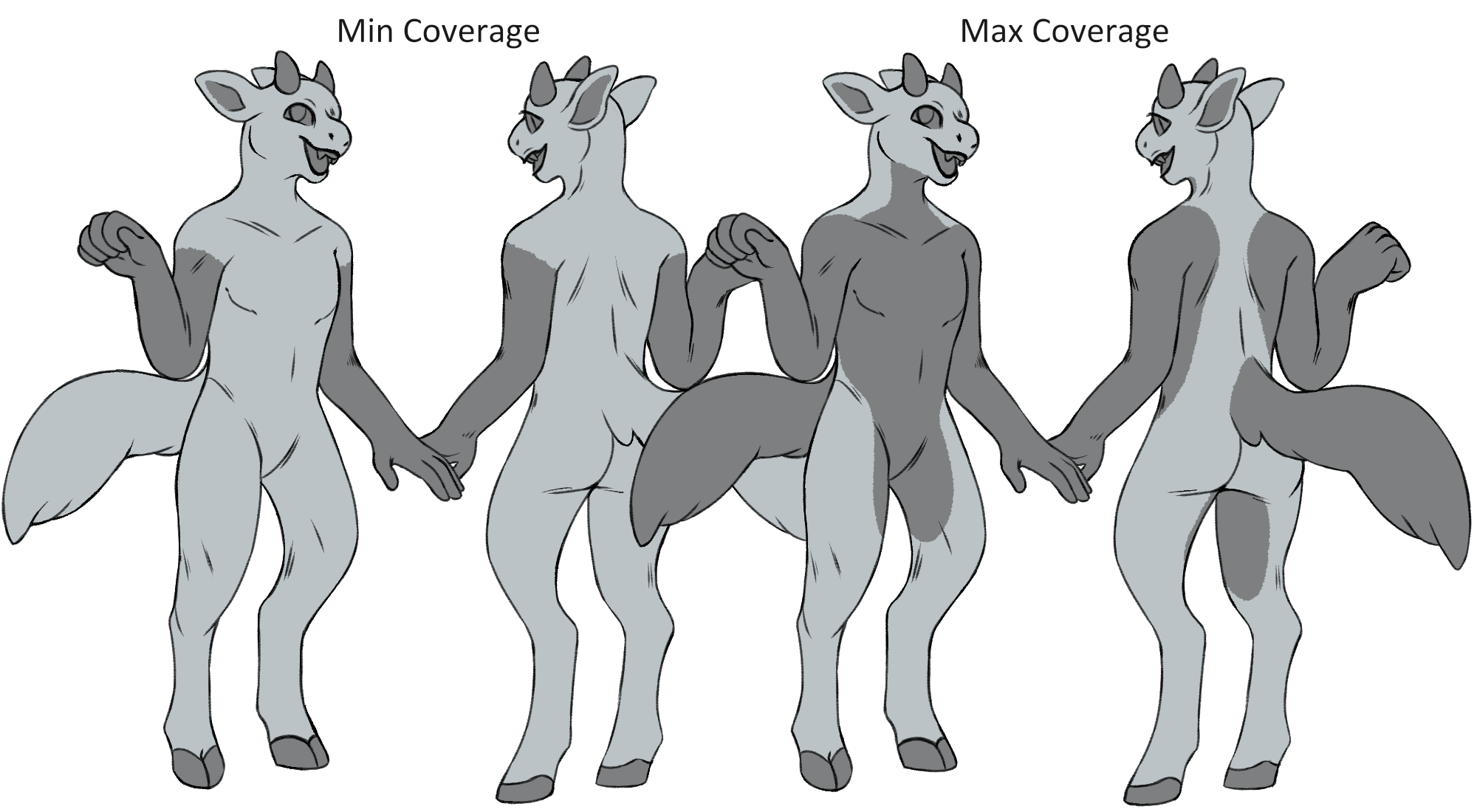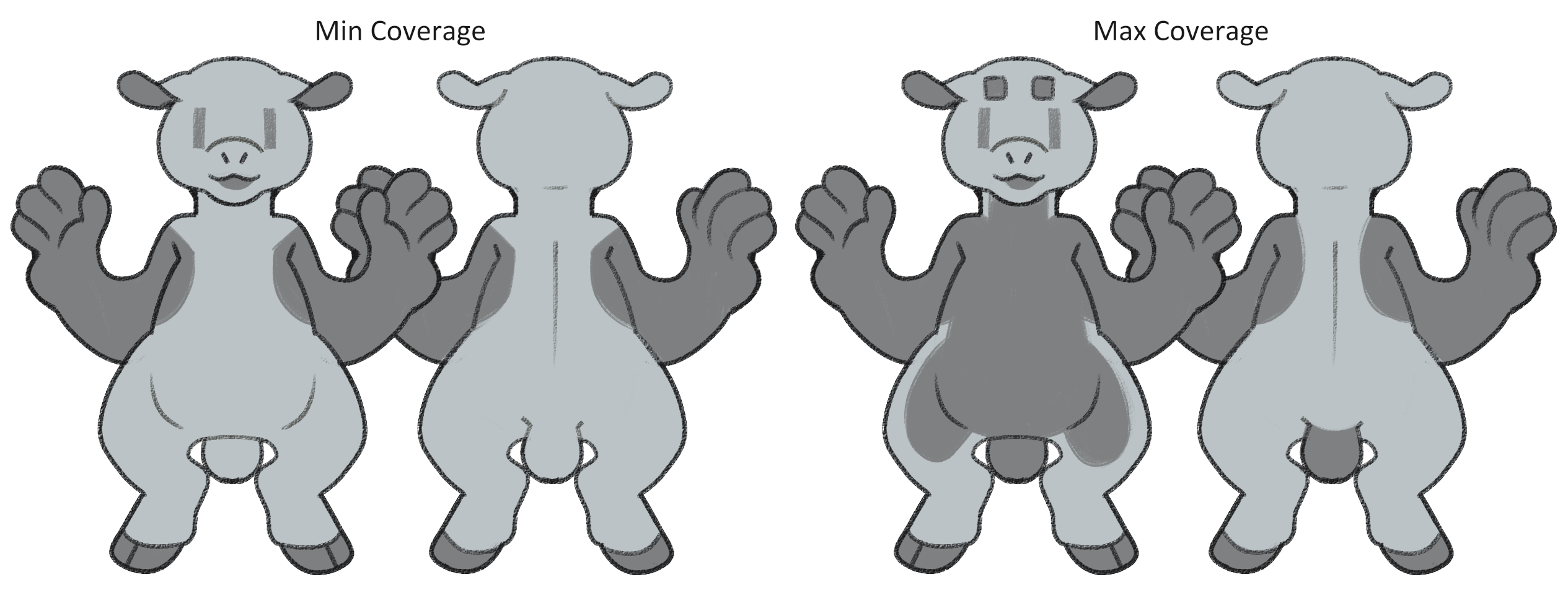Basics
Mhoats are physical embodiments of magic, their bodies are made of a physical form of magic called aethic. Aethic is malleable and allows mhoats to transform between a quadrupedal and bipedal form. Flexible plates of hardened silk cover every part of the body where aethic doesn’t show through, these are formed naturally as a protective layer between themselves and the environment around them. The plating is usually subtle, obscured by soft fur-like strands of silk that sprout from the surface of the plates. The seams are visible at night when a mhoat’s natural bioluminescence shines through the seams of the opaque plating that covers their bodies.
Given their magical nature mhoats come in a range of different appearances, the various traits they present occur more often than others. Mutations or mythic traits are often a result of a mhoat's natural magic or an encounter with wild magic altering their appearance. Outside of these random magical influences, there are food items that mhoats find in the wild (mutation stones) or make during seasonal festivities (fruit drop jelly) that can draw forth specific traits that a mhoat desires.
Some mythic traits are viewed as special or significant, grayscale aethic for example is thought to be from a touch of the magic wielded by the mhoat deities, Yel and Myn. White, associated with Yel is viewed as a blessing, a sign of good fortune while black, associated with Myn is viewed as something to be treated with wariness, an ill omen. The colors presented in a mhoat's aethic are thought to be an embodiment of their magic; the colors present on their plating don't carry this same meaning which is why a much wider range of colors is present on the protective plating covering their bodies.
Mhoat Bioluminescence
Mhoat's constantly give off a subtle glow that is more apparent in low light. This light is passively produced as a mhoat's body works through its natural processes; the heart pumping blood, the lungs taking in and converting oxygen, or even a mhoat processing the food it consumes are all processes that produce this light. The reason these processes produce light is due to the mhoat ability to create silk, using its internal magic to burn off impurities that would otherwise weaken or alter the quality of the silk being produced.
Beyond the production of silk, diet can also contribute and cause a mhoat's bioluminescence to increase in intensity. When an item a mhoat consumes contains magic, it can increase the light a mhoat produces. In some cases, the magic an item contains is enough to alter a mhoat's form but with items that carry low levels of magic, it will be burnt off in the process to increase the quality of a mhoat's silk production. This is because mhoat's do not absorb outside magic, so unless it meets a certain threshold it will only be worked out of a mhoat's body versus altering the mhoat.
Silk Info
Mhoats naturally produce a protective layer on the parts of their body that lack a shell. This protective layer is formed from fine layers of silk that build up slowly over time. It begins as a liquid that slowly dries out into thin sheets of silk that a mhoat can pull from their body at any time to be used for a variety of things.
Depending upon the state the silk starts (liquid or dried), a mhoat can make a variety of useful things and with further processing can make even more. The liquid form is perfect for use as a glue, elastic binding, adhesive bandaging, etc. while the dried form can be worked into thread for fabrics, used to wrap and preserve items long term, and other such uses. When processed further the silk can be made into paints, paper, construction materials, and many other things.
Liquid is the default state of silk and can be produced very quickly and continuously as a mhoat needs so long as the mhoat in question is well-fed and healthy. Dried silk takes longer to produce and as a result, is a bit more difficult for a mhoat to produce in significant quantities, but is still commonly available, especially among mhoats who work with silk fabrics.
Beyond its uses, a mhoat's silk naturally takes on the color of the mhoat's goo. This color isn't always obvious but when layered or gathered in a mass it begins to show its color. If a mhoat desires a different color or a unique quality to develop in fresh layers of silk they would need to eat foods of that color or quality to produce that type of silk. Examples of this are a mhoat eating green foods to create green silk or eating gold to produce silk with the shimmery quality and color of gold.
Aethic
A mhoat's entire body is formed of a malleable goo-like substance that is called aethic. Areas covered in plating naturally confine this malleable goo into a solid form, but the uncovered areas of a mhoat's body are able to transform with some level of freedom so long as those areas remain usable to the mhoat. A mhoat's arms have the most freedom in transforming, the limbs mimicking various tools and types of arms and legs depending on the mhoat's current form being feral or anthro. Some common transformations mhoats are seen using are a sickle for cutting crops or chopping down mushrooms, a hammer for building, something vaguely fin-like to improve swimming, and many other possibilities exist beyond these. Alongside this arm transformation, a mhoat is able to sprout a secondary set of arms that form beneath the primary set and these can also transform similarly to the main arms. Beyond this, a mhoat is able to do some basic transformation on the hooves to allow variations such as paws, hands, and other types of feet, as well as, to extend the length of their tongue (though this is arguably a sillier thing to use these abilities on).
The aethic itself has some variation in look and feel, usually dependent upon the texture a mhoat displays. The most basic appearance a mhoat's aethic can have is either shiny and smooth or matte and velvety/soft. Beyond this, mhoats have been known to form fluffy aethic with a soft fur feeling, aethic with a cracked appearance that feels dusty or the top crumbles when pressure is applied, and other such goo textures.
Magic
All mhoats carry some latent form of magic that they were gifted by their deities.
Yel's gift is that of natural healing, most injuries can be healed so long as a piece of the mhoat isn’t lost. A lost limb can reattach itself so long as the magic in that limb doesn’t fade into the surrounding environment before an attempt can be made. Most wounds are covered in a thin layer of silk until plating can reform over the wound, this often leaves a pale impression of the aethic color on the mhoat’s coat but it fades slowly over time.
Myn's gift is one of limited transformation, mhoats can naturally shift between a quadrupedal and bipedal form at will. Along with this, mhoats are able to form a second set of arms with all of their arms able to transform at will. Even their bodies can be altered freely so long as the overall body mass remains the same, so a thin and willowy mhoat could change their body shape to be short and stocky.
Beyond these natural gifts in magic, mhoats often pursue branches of magic on their own or through lessons with other magic users either privately or through circles. Circles are places of magic research, where mhoats are dedicated to expanding the limits of known magic or unlocking new branches of study.

